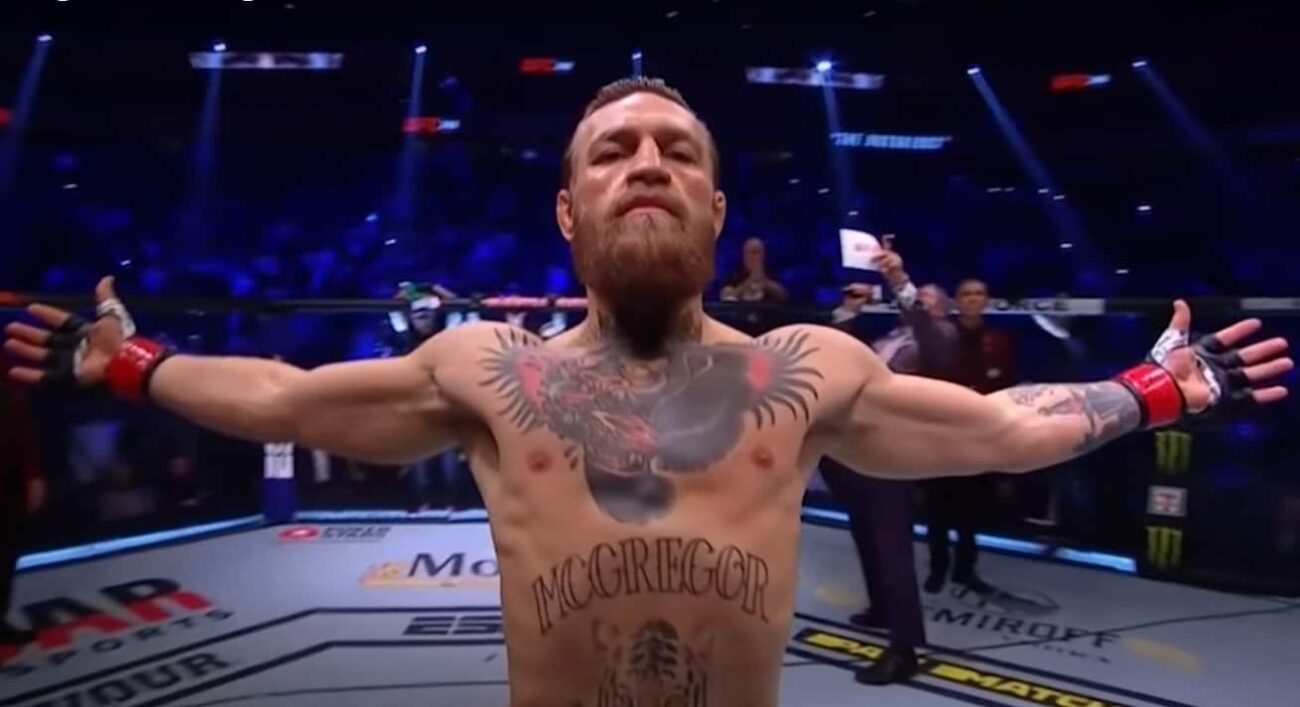We all know how height can play a significant role in a fighter’s success, but another very important factor that many fighters utilize is their reach. You see it in every fighter comparison before fights, and it sometimes varies drastically when you compare it to the fighter’s heights. So, what is the UFC reach, and how do they measure it?
UFC reach (or wingspan) is the length measuring from the tip of the middle finger on one hand to the other while the arms are raised horizontally at shoulder height. The average human height/reach ratio is 1:1, but MMA fighters tend to have a longer reach on average.
For instance, Jon Jones is 6’4’’, or 76’’ tall, but he has an 84’’ reach, which is a huge advantage for him in the Octagon. If you want to learn more about the UFC fighter’s reach, how do they measure it, how big of an advantage it can be, and who has the longest reach, keep reading this article.
How Is Reach in the UFC Measured?
A fighter’s reach is commonly mistakenly equivalent to their height. However, height and reach aren’t the same things, nor are they measured the same.
To measure a fighter’s reach, they must stand straight and raise their arms at shoulder height, perpendicular to their body. Then, the distance between the tip of the middle finger of one hand and the tip of the middle finger, on the other hand, is measured to determine the fighter’s reach.
An average human being has a 1:1 height-to-reach ratio. That means if you’re 6 feet tall, you’ll probably have a 6-foot reach, too. However, that’s not a rule, especially among UFC fighters and martial artists in general.
UFC fighters have 2-3 inches longer reach on average, meaning their height-to-reach ratio is closer to 1.05:1 than 1:1. So, an average UFC fighter that’s 6’0’’ (72’’) will have a 74’’ reach.
That difference between height and reach is called the ape index. The ape index is calculated by subtracting one’s height from their reach. [1]
Most UFC fighters have a positive ape index (around 2-3 inches), but some have negative ape indexes, meaning their height is longer than their reach.
By looking at the ape index, you can easily determine how much of an advantage a fighter has compared to others. Heavyweights are much taller than lightweights, so, logically, they’ll have a larger reach. But that doesn’t necessarily mean they have a larger ape index.
Having a long reach can definitely serve you well in the Octagon, which is why it’s more frequent to see fighters with a big ape index dominate rather than those with a negative ape index. Let’s look at some of the benefits of a long reach in MMA.
Benefits Of A Long Reach In MMA
Fighters like Francis Ngannou, Jon Jones, and Conor McGregor all have a highly positive ape index, meaning their reach is quite bigger than their height. That can be an incredible advantage, especially for the guys that are also tall, like Bones and Ngannou.
Having a height and reach advantage means that your opponents will likely have difficulty reaching you with their punches and kicks. You can set your defense a lot easier when you can afford to keep your opponent at a safe distance where they can’t reach you, but you can easily reach them.
Fighters with a long reach can prepare their attacks better, too, not just defend easier. When you have a long reach, that means you can probe and test your opponents more without getting exposed easily.
They are the ones who need to shorten the gap and shoot in if they want to do any damage, which enables you to move laterally and clip them while they’re exposed shooting inside.
To add to it, fighters with a longer reach usually have a stronger punch as well, and it’s pure physics – a larger “lever” means more swing and more torque at the end of a strike, resulting in a higher impact force.
Sometimes, the long-reach fighters need to sacrifice explosiveness for power, but one good hit and it lights out for your opponent. Just look at what Conor McGregor did in his prime. Knockouts aren’t nearly as common in the featherweight and lightweight division as he made them be.
Seeing the striking benefits of a longer reach is easy, but how about grappling? First of all, it helps you immensely with your takedown defense. Keeping your opponent at a distance means they have to shoot in to close the gap and take you down.
That distance gives you a split second more to telegraph their movement and avoid a takedown – sometimes even bang out a counter-combination.
It also helps you score more takedowns too. When you’re trying to go for a double leg from a clinch, every inch of grip with your fingers that you can get matters. A longer reach gives you more grip and makes takedowns a lot easier.
Finally, just like you’ll have more power in your punches, you’ll also have a higher grip force when attempting a submission. The principle is the same – a longer lever gives you more torque and a better grip, especially on chokes where every inch gives you such a big advantage.
Who Has the Longest Reach in UFC?
To determine how long a fighter’s reach is, you need to look at their ape index. Obviously, fighters in the biggest divisions (light heavyweight and heavyweight) will be the tallest; hence, their reach will be the longest. But, that doesn’t necessarily mean they have the longest reach compared to their height.
If you look at the longest reach in UFC history, that belongs to Dan Christison. He had a reach of 85’’, but he was a 6’8’’ fighter, so his ape index wasn’t that high. Hence, it was never really that big of an advantage for him.
On the other hand, Jon Jones has the longest reach in the UFC right now with 84.5’’. Seeing that he’s only 6’4’’, that gives him an outstanding +8.5’’ ape index, which is the second-highest ape index in UFC history (only Sergey Pavlovich has more with +9’’).
One extremely interesting fighter I’d like to mention here is Alexander Volkanovski. He stands at only 5’6’’ but has a staggering 71.5’’ reach, meaning his ape index is +5.5’’. That’s spectacular considering he’s below-average height in his division but has an above-average reach.
He had a significant reach advantage over Max Holloway in their fights, even though Holloway is a whopping 5’’ taller.
| # | Fighter | Height | Reach | Ape index |
| 1 | Sergei Pavlovich | 6’3″ | 84″ | +9.0″ |
| 2 | Jon Jones | 6’4″ | 84.5″ | +8.5″ |
| 3 | Kevin Lee | 5’9″ | 77″ | +8.0″ |
| 4 | Dalcha Lungiambula | 5’8″ | 76″ | +8.0″ |
| 5 | Uriah Hall | 6’0″ | 79.5″ | +7.5″ |
| 6 | Francis Ngannou | 6’4″ | 83″ | +7.0″ |
| 7 | Paul Daley | 5’9″ | 76″ | +7.0″ |
| 8 | Miguel Torre | 5’9″ | 76″ | +7.0″ |
| 9 | Georges St-Pierre | 5’10” | 76″ | +6.0″ |
| 10 | Brock Lesnar | 6’3″ | 81″ | +6.0″ |
| 11 | Alexander Volkanovski | 5’6″ | 71.5″ | +5.5″ |
| 12 | Tony Ferguson | 5’11” | 76.5″ | +5.5″ |
| 13 | Tyron Woodley | 5’9″ | 74″ | +5.0″ |
| 14 | Conor McGregor | 5’9″ | 74″ | +5.0″ |
Who Has the Shortest Reach in the UFC?
The shortest fighters tend to have the shortest reach, so the women’s strawweight division has the shortest average reach. However, it wouldn’t be fair to compare them with much taller individuals, so we’ll look at the lowest ape indexes in history instead.
By far, the lowest ape index in UFC history belongs to Artem Lobov, Conor McGregor’s gym partner. Lobov is 5’9’’ but has a 65’’ reach, meaning his ape index is -4’’, giving him the biggest negative ape index in UFC history.
They are the same height compared to Conor McGregor, but Lobov has a 9.5’’ shorter reach. Talk about T-Rex arms, right?
Other notable fighters with a negative ape index are Justin Gaethje (-1’’), Max Holloway (-2’’), Cody Garbrandt (-2’’), etc.

